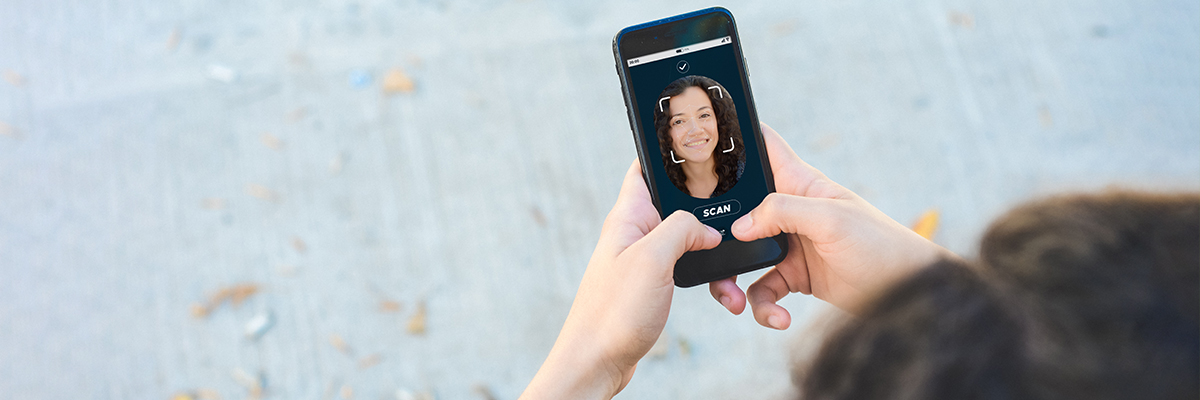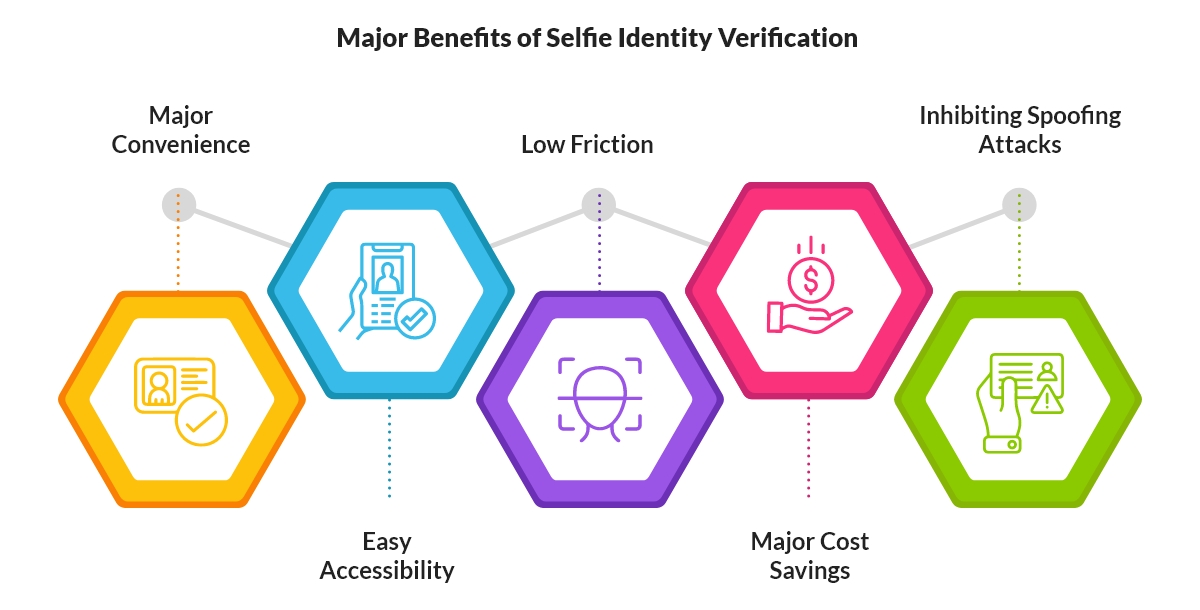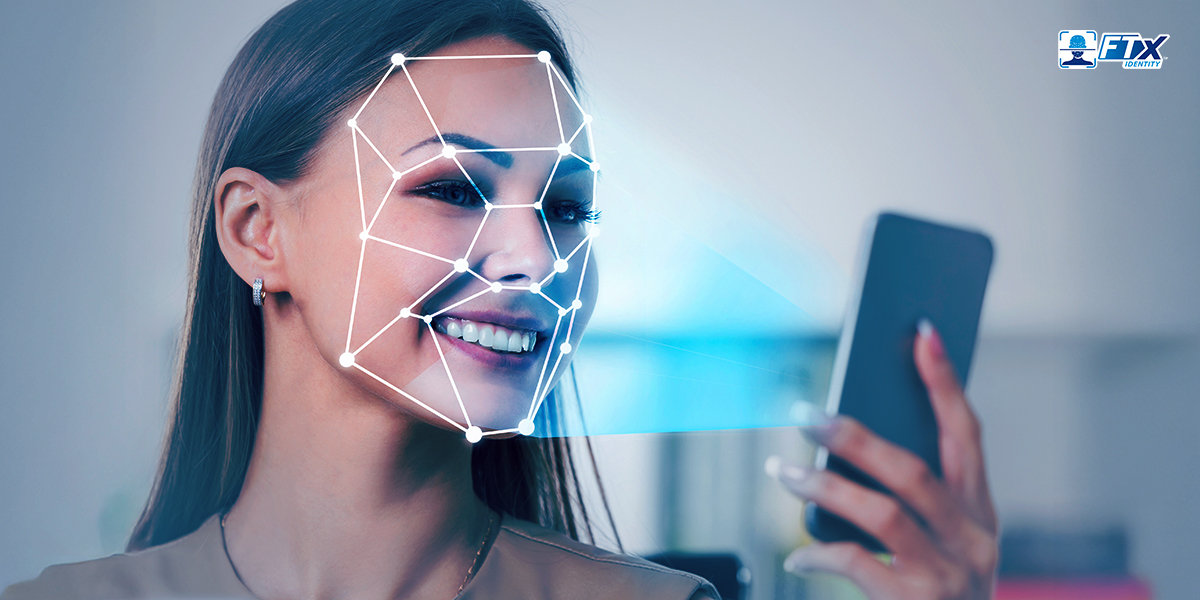In 2004, Philip Cummings pleaded guilty to one of the largest identity theft cases ever recorded in the United States.
As a help desk worker at a Long Island credit software firm, he stole login details, accessing over 30,000 credit reports. He sold this data for up to $60 each, causing an estimated $50-$100 million in losses.
This identity theft poses a question – what measures can individuals and companies take to prevent such large-scale identity theft?
In this blog post, we will explore the importance of selfie identity verification, which could be one of the answers to cutting down the losses from identity theft.
According to identitytheft.org, 1 in 3 Americans have faced some form of identity theft attempt in their lives. It’s easy to fall prey and become a part of this statistic.
Learn How Proactive Identity Verification Platform Can Help Your Business
What Is Selfie Identity Verification?

Selfie verification is a form of biometric verification that involves comparing a selfie with a government-issued ID. For example, you might take a photo of a driver’s license, state ID, or passport. Then, your live image is used to cross-reference and authenticate the user’s identity.
In certain situations, additional forms of identification may be necessary, such as a video selfie or video call. However, for the majority of establishments, a simple selfie will do (along with liveness detection).
This method is not often used on its own; instead, it is often combined with other validation methods such as database verification and document verification in order to establish a highly secure and all-encompassing identity verification procedure.
The Technology Behind Selfie Identity Verification
Selfie verification is a process that’s so much more than just taking a photo of yourself. It’s a process that is backed up by various technologies. Let’s understand the mechanism behind photo verification.
1. Liveness Detection
Liveness detection helps in assuring that the person taking the selfie is physically present and 3D-rendered model, video, or image.
Liveness detection captures real-time biometric data to confirm the physical presence of the user. Also, it helps prevent fraud by verifying the authenticity of the selfie. All the micro-movements, pixel-level irregularities, or reflections are being taken care of using liveness detection.
2. AI-Powered Facial Recognition
Facial recognition technology can analyze and compare facial features with an official document to verify a person’s identity. It involves using deep machine learning algorithms to perform at max level.
More often than not, scammers try to bypass photo verification using masks, stolen photos, or videos. To put a stop to this, AI-powered facial recognition involves anti-spoofing measures such as:
- Infrared & thermal imaging – Detects temperature differences between real and fake skin.
- Texture & depth analysis – Detects 3D depth to differentiate a flat image from a real face.
- Facial expression recognition – Makes sure that the person at the end is physically present by requiring them to perform certain actions.
How Does Selfie Identity Verification Work?

Using a camera phone for verification commonly involves the following steps:
1. The individual must present their government-issued ID, take a photograph of it, and subsequently upload it.
2. The information of the ID is compared to multiple official databases and other provided information to detect any inconsistencies.
3. In order to verify the person’s identity, they are required to take and submit a selfie. The selfie must be of high quality, well-lit, and show the person’s entire face without any obstructions.
4. The selfie or video provided by the person is subsequently examined to confirm its authenticity and compared to the photo on the identification document.
Note: If the verification uses liveness detection, the user may be asked to move the camera around for a facial scan.
Selfie ID Verification to Your KYC Workflow
We live in an era where proving who you are online is less about passwords and more about, well, you.
Let’s peel back the layers and explore how this technology integrates into the broader identity verification arena.
1. Document Verification
Think of this as the foundational layer. Traditionally, Know Your Customer (KYC) hinges on verifying government-issued documents like passports or driver’s licenses. Selfie verification often works in tandem, requiring a user to photograph their ID alongside their selfie.
This adds a crucial layer of liveness and corroboration, ensuring the person holding the document is indeed the person in the selfie and that the document itself isn’t a static image.
2. Email Verification
A classic, yet still relevant step. Email verification confirms ownership of an email address, often through a unique link or code. While not a direct form of identity verification on its own, it acts as an important contact point and a piece of the overall puzzle.
3. Phone Verification
Similar to email verification, confirming a phone number adds another layer of authentication. Often involving a short message service one-time password (SMS OTP), it verifies that the user controls the provided phone number.
4. Captcha Detection
While seemingly basic, CAPTCHA (Completely Automated Public Turing test to tell Computers and Humans Apart) serves a vital role in distinguishing human users from bots, preventing automated fraudulent activities during the onboarding process.
5. Trusted Identity Network
Imagine a network where verified identities can be securely shared and reused with consent. This reduces the need for repeated verification, creating a smoother user experience while maintaining security. Selfie verification can contribute to building trust within such networks by providing a biometric anchor to a digital identity.
6. Multi-Factor Authentication (MFA)
Security best practice 101. MFA layers different types of verification together – something you know (password), something you have (phone), and something you are (biometric, like a selfie). Integrating selfie verification as one of these factors significantly strengthens the overall security posture.

7. Other Biometric Methods
Selfie verification isn’t the only biometric in town. Fingerprint scanning, facial recognition (beyond just a selfie), and iris scans are other methods used for identity proofing. Often, the choice depends on the device capabilities and the level of security required. Selfie verification offers a relatively accessible entry point, as most modern devices are equipped with cameras.
Challenges of Selfie Identity Verification
While promising, relying on selfies for identity verification isn’t without its hurdles.
1. Liveness Detection and Spoofing
The crucial question: is the person in the selfie actually a live human being? Sophisticated fraudsters are constantly developing ways to spoof these systems using high-quality photos, videos, or even masks. Robust liveness detection techniques – analyzing subtle movements, textures, and even physiological signals – are essential to counter these threats.
2. Inconsistent Image Quality
Poor lighting, blurry images, or obstructions (like a hand partially covering the face) can lead to verification failures. Ensuring users can easily capture clear and usable selfies is a significant UX challenge.
3. Bias and Accuracy Across Demographics
Like many AI-powered systems, facial recognition technology can sometimes exhibit bias across different demographic groups based on skin tone, gender, and age. Developers must actively work to mitigate these biases to ensure fair and accurate verification for all users.
4. Matching Errors
Even with a clear selfie and a valid document, the system might incorrectly reject a legitimate user due to subtle differences in appearance (e.g., changes in hairstyle, lighting variations between the document photo and the selfie). Fine-tuning the matching algorithms is critical to minimize false negatives.
5. Data Privacy and Storage Risks
Handling biometric data like facial images requires stringent security and adherence to privacy regulations. Secure storage, encryption, and clear policies on data usage are paramount to maintain user trust.
6. User Experience (UX) Friction
While seemingly simple, the selfie verification process can sometimes introduce friction. Users might struggle to take an acceptable photo, or they might have concerns about privacy. A well-designed and intuitive user flow is crucial for adoption.
7. Synthetic Identity and Deepfake Threats
The rise of synthetic identities (combinations of real and fabricated information) and increasingly realistic deepfakes poses a significant challenge. While liveness detection aims to combat some of this, the technology needs to continuously evolve to stay ahead of these sophisticated threats.
Major Benefits of Selfie Identity Verification

It offers significant benefits for both individuals who need to verify their identity and the business.
Let’s explore some major benefits:
1. Major Convenience: First and foremost, the first thing that stands out about this form of verification is the convenience of it. Individuals can verify their identity from their home without the hassle of visiting a physical location.
2. Easy Accessibility: This method of verification is easily accessible because individuals only need to have their smartphone or webcam on hand to proceed with the verification process!
3. Low Friction: By simply taking a selfie, the hassle of going through multiple ID checks is disregarded. This significantly improves user compliance with verification procedures.
4. Major Cost Savings: Selfie identity verification offers significant cost savings for businesses, reducing labor costs and preventing fraud losses. It seamlessly integrates with existing systems and streamlines processes, providing convenience and efficiency.
5. Inhibiting Spoofing Attacks: The combination of selfie identity verification and liveness detection effectively thwarts spoofing attacks. The process of live detection involves analyzing facial movements, head gestures, blinking patterns, and other factors to determine if a person is physically present or if they are represented by an image or video. This prevents malicious individuals from pretending to be someone else using pre-recorded videos or images.
Privacy and Data Security
The collection and processing of biometric data necessitate a strong commitment to user data protection and compliance with relevant regulations (like GDPR, CCPA, etc.). This includes transparent data handling policies, secure storage with robust encryption, and providing users with control over their data. Building trust hinges on demonstrating a clear commitment to safeguarding user privacy throughout the selfie verification process.
Selfie Identity Verification Use Cases
This verification method isn’t just a technological novelty; it’s a practical solution enhancing security, convenience, and efficiency across a multitude of industries. Let’s explore some key applications:

1. Ecommerce: Businesses can fortify their platforms by verifying the identities of both buyers and sellers during account creation, for high-value transactions, and to combat fraud. This builds trust and ensures a safer marketplace for everyone.
Ready to enhance the security of your online store? Explore How
2. Tobacco Stores: Online sales of age-restricted products like tobacco require stringent age verification. Selfie ID verification ensures that purchasers meet the legal age requirements, adding a layer of security beyond simple self-declaration.
3. CBD Shops: Similar to tobacco, the sale of CBD products often has age restrictions and compliance requirements. Selfie verification provides a secure method to confirm the buyer’s age and identity online.
4. Online Gaming: Verifying the identities of players in online gaming environments can help prevent fraud, smurfing (experienced players using new accounts to play against less skilled opponents), and ensure fair play.
5. In-Store Age Verification: While the focus has been online, selfie verification can also play a role in physical retail. Imagine a self-checkout system in a convenience store using a quick selfie to verify a customer’s age for purchasing restricted items, offering a faster and potentially more private alternative to manual checks.
6. Convenience Retail: Beyond age-restricted items, convenience stores with online ordering or loyalty programs can use selfie verification during account creation or for redeeming rewards, adding a layer of security and personalization.
7. Liquor Stores: Online liquor sales, like tobacco and CBD, necessitate strict age verification. Selfie ID verification provides a secure and convenient way to ensure that only individuals of legal drinking age can make purchases.
Emerging Trends in Selfie Verification
The field of selfie verification is dynamic, with several exciting trends on the horizon.

1. AI Improvements and Deepfake Detection
Advancements in artificial intelligence and machine learning are continuously improving the accuracy and robustness of selfie verification, particularly in the realm of liveness detection and the ability to identify increasingly sophisticated deepfakes.
2. Use of Behavioral Biometrics with Selfie Checks
Imagine a system that not only analyzes your face but also how you interact with your device during the selfie process – the speed of your movements, the pressure you apply. Integrating these “behavioral biometrics” with selfie checks could add another powerful layer of security.
3. Reusable Digital IDs and Decentralized ID Systems
The future might see users holding reusable digital identities, potentially built on decentralized technologies. Selfie verification could play a crucial role in the initial creation and ongoing authentication of these portable digital credentials, reducing the need for repeated verifications across different services.
Wrapping Up
Ultimately, selfie identity verification redefines what customer onboarding can look like for businesses and users alike. It is essential for those wanting to unlock a major shift in their business and make every interaction secure and efficient. Therefore, if you are looking to ensure the best experience for customers while providing secure access to your services, make sure that implementing selfie identity verification is part of your strategy.
To learn more about how FTx Identity can benefit your business, be sure to reach out to us today to set up your consultation and experience a demo!
Secure, Efficient, and User-Friendly Solutions for Your Business
At FTx Identity, we’re committed to helping businesses stay one step ahead of fraud. Whether you’re looking to protect your customers or enhance your onboarding process, we offer comprehensive tools tailored to your needs.
